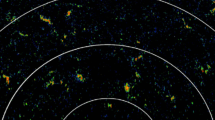Abstract
It is a basic feature of the Babcock-Leighton model of the solar cycle that the polar field reversal is due to the diffusive decay and poleward drift of the active region fields. The flux from follower regions moves preferentially polewards in each hemisphere, where it cancels with, and then replaces, the previously existing polar fields. A number of workers have attempted to model this process by numerical solutions of the flux transport equation, which include the surface effects of supergranule diffusion, differential rotation and meridional flow, with conflicting results.
Here we describe recent changes in the polar fields using synoptic magnetic data provided by the Mount Wilson Observatory, and compare them with simulations using the flux transport equation and based on the observed fields for Carrington rotation 1815. These changes include a part-reversal of the north polar field. It is shown that the evolution of the polar fields cannot be reproduced accurately by simulations of the diffusion and poleward drift of the emerging active regions at sunspot latitudes.
Histograms of the distribution of the field intensities derived from the daily magnetograms obtained at the Kitt Peak Station of the National Solar Observatory provide independent evidence that flux is emerging at high latitudes and that this flux makes a contribution to the evolution of these patterns. This implies the presence of some form of sub-surface dynamo action at high latitudes.
Similar content being viewed by others
References
Babcock, H. W.: 1961, Astrophys. J. 133, 572.
Devore, C. R. and Sheeley, N. R., Jr.: 1987, Solar Phys. 108, 47.
DeVore, C. R., Sheeley, N. R., Jr., and Boris, J. P.: 1984, Solar Phys. 92, 1.
Leighton, R. B.: 1964, Astrophys. J. 140, 1547.
Leighton, R. B.: 1969, Astrophys. J. 156, 1.
Martin, S. F. and Harvey, K. L.: 1979, Solar Phys. 64, 93.
Murray, N.: 1992, Astrophys. J. (submitted).
Sheeley, N. R., Jr., Nash, A. G., and Wang, Y.-M.: 1987, Astrophys. J. 319, 481.
Snodgrass, H. B.: 1983, Astrophys. J. 270, 288.
Wang, Y-M., Nash, A. G., and Sheeley, N. R., Jr.: 1989, Science 245, 712.
Wang, Y-M., Sheeley, N. R., Jr., and Nash, A. G.: 1991, Astrophys. J. 383, 431.
Wilson, P. R.: 1992, Solar Phys. 138, 11 (Paper III).
Wilson, P. R. and McIntosh, P. S.: 1991, Solar Phys. 136, 221 (Paper II).
Wilson, P. R., McIntosh, P. S., and Snodgrass, H. B.: 1990, Solar Phys. 127, 1 (Paper I).
Wilson, P. R., Altrock, R. C, Harvey, K. L., Martin, S. F., and Snodgrass, H. B.: 1988, Nature 333, 748.
Author information
Authors and Affiliations
Additional information
On leave from the School of Mathematics, University of Sydney.
Rights and permissions
About this article
Cite this article
Murray, N., Wilson, P.R. The reversal of the solar polar magnetic fields. Sol Phys 142, 221–232 (1992). https://doi.org/10.1007/BF00151451
Received:
Revised:
Issue Date:
DOI: https://doi.org/10.1007/BF00151451




